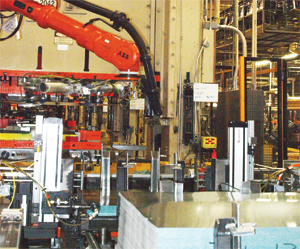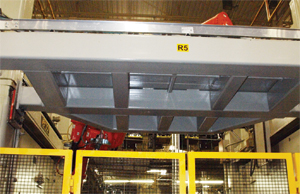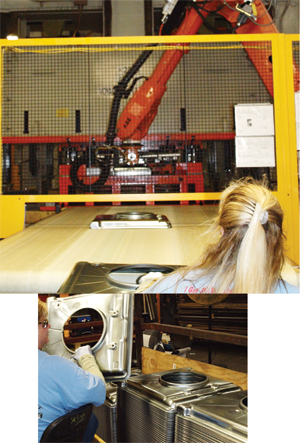Robots Move Dishwasher Parts Press-to-Press
May 1, 2010Comments
The largest dishwasher plant in the world--Whirlpool in Findlay, OH--automates three tandem lines with press-to-press robotics to tackle a new stainless-steel model. Specially engineered destacking systems handle the challenges presented by inhouse blanking with dry-lube application.
In 2008, engineers at the Whirlpool Corp. dishwasher plant in Findlay, OH, were tasked with developing a whole new of assembling stainless-steel tubs. And the new assembly process required a new approach to part design. Jay Hipsher, the plant’s lead process engineer for metal stamping, led the efforts to tackle that task. “Attempting to manufacture the new stainless-steel tub components through our three automated press lines,” he says, “it quickly became clear that the 1990s-vintage press-line automation would not stand up to the task at hand.”
 |
| The entry end of press-line B where a Rexroth-driven air-knife system separates blanks and an overhead-mounted camera system checks blank position (as needed) before blanks feed into the first press, for drawing dishwasher-tub bottoms. |
Robotics a Clear Winner
“We looked at several styles of press-to-press automation systems to upgrade our lines,” Hipsher says, “and robotics clearly made the most sense, particularly when considering the accuracy of placing blanks in the first operation (draw forming). Also, our production runs have been shrinking to keep pace with lean initiatives throughout the plant. We’ve seen inventory levels drop from what used to be a week to just a day, which means we have to change dies much more often than we used to—typically twice a week or so. Thanks to our new robotic transfer setups, we can change over the stamping lines in 90 min. or less, whereas line changes used to take as long as an entire shift. And, now there’s no debugging needed—we call up the new robot program, change the dies and we’re good to go.”
 |
| Overhead shelf-mounted robots along B line transfer tub-bottom stampings to keep the front area of the press clear to accommodate die changes. |
Of the three press lines producing stainless-steel stampings—six SKUs in all—A line comprises six presses and stamps two styles of inner doors; B line employs six presses and stamps two styles of bottoms and one top; and D line houses four presses to make the tub wrappers and includes a conveying line with a pick-and-place robot to automate parts cleaning. Press capacity ranges from 200 to 600 tons. B and D lines hit the production floor in mid-2008; A line was delivered in February 2010 and was being installed during my visit to the plant in mid-March, with a scheduled startup date of April 10.
The plant’s robotic supplier of choice: ABB Inc.’s press-automation systems group, in Brampton, Ontario, Canada. ABB also integrated new blank-destacking technology and developed custom vacuum-cup-style end-of-arm tooling to handle the various blanks, including the double-wide blank used to stamp the tops two-out. Several of the press-to-press transfer robots on A and B lines (model IRB 6650S robots, 3.5-m reach, 125-kg payload capacity) mount overhead on shelves, keeping the front of each press clear to facilitate die-cart access for simplified die changes. Destacking and unloading robots, as well as inter-press robots on D line, are floor-mounted IRB 6640 models—3.2-m reach, 130-kg load capacity. Accompanying the move to robotics was an upgrade of all press controls to new OmniLink 5000 press and automation controls, with Omni-link II operator terminals, from Link Systems.
Inhouse Dry-Lube Application a Sticking Point
Stainless steel comes in the door in coils weighing as much as 20,000 lb, and route through the plant’s shear line, complete with straightening and leveling operations and the application of a dry lubricant—Chemform from PPG. The line then cuts and stacks blanks.
 |
| End of line B, where an operator stacks completed tub bottoms and sends them on their to the clinch-seaming machine for assembly to the tub wrapper. Seaming requires a very thin and tightly toleranced flange around the perimeter of the part —the accuracy and repeatability of the press-loading robots ensures the precision of this flange dimension to avoid a problem at the seaming line, where one misstep means scrapping out an entire tub. |
“The fact that we apply the lube inhouse,” says Hipsher, “creates a challenge for us. Rather than having the lube applied at a service center on a long line that allows the lube to cure before blanking and stacking, our relatively short line limits the curing time for the lubricant. This means that the lube has to finish curing in the stack (you can actually feel the heat coming from the stacks as the lube cures). This can cause the blanks to stick together, more so in the humid summer months.”
Blank adhesion from curing dry lube once caused headaches for the plant’s press-line operators, until ABB’s press-automation team took on the new automation project for Hipsher and his group. To ease robotic destacking at the front of the press lines, ABBdesigned and integrated air-knife fanning systems driven by a Bosch Rexroth/Indramat servo drive.
“Our operators used to spend a considerable amount of time dealing with destacking each of the lines—adjusting, moving, prying, etc.,” says Hipsher. “Now, while the robots have reduced cycle time through each line from 9 to 10 sec. to as little 7 sec., our OEE (overall equipment effectiveness) has soared because we’re not shutting down the lines to manually separate blanks to avoid hitting doubles. Net production through our three lines has nearly doubled.”
Enrique Pano, business development manager for ABB Press Automation North America, adds: “Robotic automation on these lines provides Whirlpool an optimum balance between cycle time, flexibility and uptime.”
Eddy-Current Thickness Sensing, Vision-Based Position Sensing
At the beginning of each destack cycle, an eddy-current sensor checks for double blanks; a positive result sends the robot back to the stack to release its load and try again. It makes three attempts to pick one blank before calling for operator intervention. Also, at the beginning and end of each stack, an ABB-engineered vision system kicks in to inspect blank position in space. An overhead camera snaps a photograph of the blank as it’s held by the robot end-of-arm vacuum-cup gripping tool and compares its position to the programmed position.
“The only time we see any variability,” says Whirlpool electrical controls engineer Mark Cosiano, “is the first and last inch or so of each 2-ft. stack of blanks. Any offset data immediately gets fed to the robot controller to adjust blank positioning in the press on the fly, with no noticeable increase in cycle time. And it’s that initial positioning in the first draw die that’s critical—that die sets the clinch-seam flange and creates the part features that ultimately fixture the stamping in the remaining presses in the line.” MF
View Glossary of Metalforming Terms
Technologies: Lubrication, Pressroom Automation, Sensing/Electronics/IOT








 Video
Video